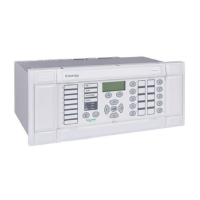Operation P54x/EN OP/La4
MiCOM P543, P544, P545 & P546
(OP) 5-39
OP
1.12.4 Right hand resistive reach line (Distance option only)
Z
R
V
I
- R
V
I
P1175ENa
P1134ENa
Figure 22 Resistive reach line (load blinder) (Distance option only)
A load blinder is formed by the phase comparison between an operating signal V/
- R and a
polarizing signal Z
Where:
V is the fault voltage
is the fault current
R is the resistive reach of the blinder
Z zone reach setting (including neutral compensation for ground distance)
Operation occurs when the operating signal leads the polarizing signal.
1.13 Quadrilateral phase resistive reaches (Distance option only)
The
resistive reach setting is used to select the resistive intercept of the quadrilaterals – the
right-hand side of the zone. Note that the RPh setting applied defines the fault arc
resistance that can be detected for a phase-phase fault. For such a fault, half of the fault
resistance appears in the positive sequence network, and half in the negative sequence
network. Therefore, as most injection test sets will plot impedance characteristics in positive
sequence terms, the right-hand intercept will be found at half the setting applied (= Rph/2).
1.14 Quadrilateral ground resistive reaches (Distance option only)
The
resistive reach setting is used to select the resistive intercept of the quadrilaterals – the
right-hand side of the zone. Note that the RG setting applied defines the fault arc resistance
that can be detected for a single phase-ground fault. For such a fault, the fault resistance
appears in the out and return total fault loop, in which the line impedance is Z1 x (1 + kZN).
Therefore, as most injection test sets will plot impedance characteristics in positive sequence
terms, the right-hand intercept will be found at less than setting applied ( = RG/[1+kZN] ).
1.15 Advanced distance elements zone settings (Distance option only)
For
most applications the user will configure the relay in “Simple” setting mode, whereby all
zone reaches are based on the protected line impedance, scaled by a reach percentage. In
such a case there is then no need to set the individual zone ohmic reaches and
compensation factors, because the automatic calculation will already have determined these
settings. Therefore with Simple settings, the menu column GROUP x DISTANCE
ELEMENTS will merely be a list of what settings have been automatically calculated and
applied. This list is useful as a reference when commissioning and periodic injection testing.

